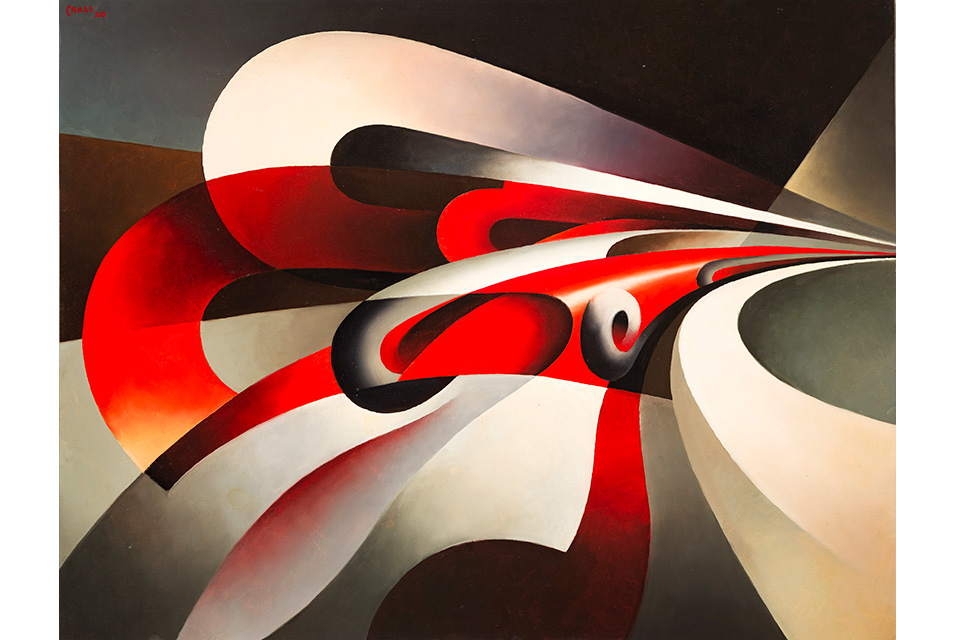Exhibition at the Estorick Collection of Modern Italian Art explores Tullio Cralis entire career

Artdaily_LONDON.- For Tullio Crali (1910-2000) Futurism was not just a school of painting, but an attitude to life itself. Reflecting the movement’s enthusiasm for the modern world, his powerful imagery embraced technology and the machine as key sources of creative inspiration. Crali’s work focused on “the immense visual and sensory drama of flight”, and is most closely associated with the genre of ‘aeropainting’, which dominated Futurist research during the inter-war years. A new exhibition of works by this towering figure of Italian modernism explores his entire career, and features over 60 rarely seen pieces from the artist’s family collection, dating from the 1920s to the 1980s. A Futurist Life is the first show in the United Kingdom to be dedicated to Crali, and runs from 15 January until 11 April 2020 at London’s Estorick Collection of Modern Italian Art.
Crali grew up in the Dalmatian city of Zadar, which was annexed by Italy following the First World War. His family moved to Gorizia in 1922 and it was there, at just 15 years of age, that he read a newspaper article about Futurism. An immediate convert, he began experimenting with the movement’s aesthetics, and created his first Futurist drawing in 1925 (a work that is included in the present exhibition). By the mid-1930s, Crali had become one of Futurism’s key players, experimenting with fashion, theatre, architecture and graphic design; but it was as an aeropainter that he truly excelled.
Throughout the 1930s, countless attempts were made by Futurist artists to capture the visual novelties experienced in flight – such as vertiginous, topsy-turvy landscapes – as well as its metaphysical dimensions. Crali’s own thrilling, lyrical imagery challenged conventional notions of realism through its dynamic perspectives and effective combination of figurative and abstract elements.
During the 1940s, Crali was one of a number of Futurists who participated in official war art programmes, accompanying pilots on combat and reconnaissance missions. Such entanglements with Mussolini’s regime later damaged Futurism’s reputation, yet Crali was profoundly cynical about political dogma, having been a victim of ideological extremism himself. Between 1944 and 1945, his organising of avant-garde cultural events in Gorizia led to clashes with the occupying Nazi authorities, who identified him as subversive and earmarked him for deportation to Germany. Crali escaped this fate thanks to an influential friend, only to be imprisoned in appalling conditions for 45 days by Tito’s militia before being liberated by American troops.
Immediately after the war, Crali moved to Piedmont where he painted works inspired not by the machine but by nature, whilst continuing to adhere to Futurist aesthetics. He noted: “My art changes form, but not substance. A lack of faith in mankind leads me to turn my attention to nature. I search out serenity in everything; I try to discover the movements of nature and to express its vitality. It is the Futurist principle of ‘universal dynamism’ that is striving to take form. There is no change of ideology.”
Throughout the post-war period Crali would be Futurism’s staunchest advocate, the movement’s leader F.T. Marinetti having entrusted him with the task of defending Futurism’s historical significance and its continued relevance. However, in 1950, disillusioned by the apathy of many of his former colleagues, Crali accepted a position as an art teacher at a prestigious Italian school in Paris, remaining there for almost a decade. During his time in France, Crali’s visits to Brittany’s rugged coastline would inspire his theory of Sassintesi : a fusion of the Italian words sassi (stones) and sintesi (synthesis). Comprising geological formations shaped by wind and water, these compositions were either entirely abstract or figurative in character, recalling elements of objective reality.
Crali was based in Egypt for much of the 1960s, teaching at the Italian Art School in Cairo. He remained firmly attuned to contemporary scientific developments, addressing humanity’s exploration of the universe in monochromatic images resembling swirling galaxies or extra-terrestrial landscapes viewed through the windows of a spaceship.
As well as the iconic aeropaintings, this exhilarating exhibition includes works of experimental poetry and mixed-media compositions, a large number of Sassintesi and examples of Crali’s later ‘cosmic’ imagery.
The exhibition will be accompanied by a fully-illustrated catalogue containing essays by the curators Christopher Adams and Barbara Martorelli.
